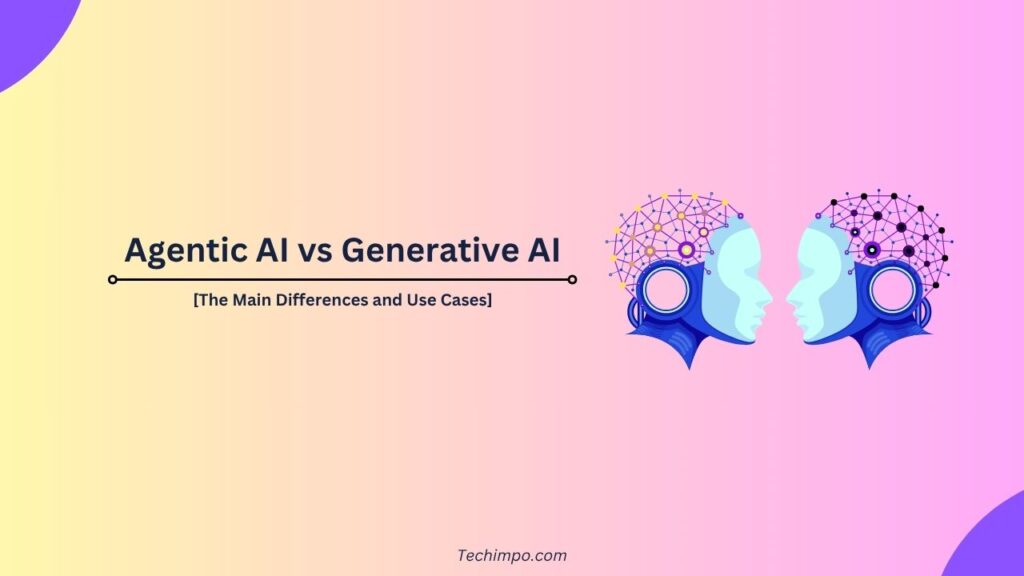The artificial intelligence field keeps evolving at a high rate. Generative AI takes up most of the media space, but Agentic AI keeps growing in significance as an emerging technology. Most individuals have heard these terms but find it difficult to comprehend their differences.
Generative AI and Agentic AI are sophisticated technologies with independent operations from one another and provide distinct capabilities. The differences between them and the real-world problems they solve are discussed in the next section.
What is Generative AI
Generative AI is an intelligent creation of content from existing data. It studies various patterns in text, images, audio, or code and then uses such knowledge to produce similar outputs.
Given a prompt, it predicts the appropriate response. It does not, therefore, create ideas from scratch. Instead, a generation builds upon its prior learning to craft a more or less original-looking product.
However, in line with what other industries might have been applying this technology for, businesses build generative AI to produce product descriptions and marketing copy, generate code snippets, and produce visuals. But Generative AI works only in a single step.
It produces a response to a prompt and then terminates. It cannot move forward with an action, perform repeated tasks, or go in another direction until told to do so by a human being. This feature makes it different from the more capable AI systems that operate autonomously.
What is Agentic AI
Agentic is an advanced kind of AI that acts on its own to accomplish complex tasks. It does not simply provide answers or create content. Whereas Generative AI very narrowly aims to answer questions about content concerning a single prompt, Agentic AI works towards a goal.
You tell it what you want as a result, and it decides how to get there. It breaks down the major task into smaller-step tasks, plans an order of actions to accomplish each step, makes decisions, and if a change occurs, adjusts its plans in response to that change.
While Generative AI asks for one instruction after another, Agentic AIs, by contrast, work unattended until the completion of the set-out task. It does not merely generate content but rather acts on it.
It can use external tools, fetch information, collaborate with another system or agent, and check on its own progress. Laying plans, reasoning, and adapting make Agentic AI ideal for applications that require multiple steps to finish.
Main Differences: Agentic AI vs Generative AI
Generative AIs create content from pattern-finding on their training data, predict what may come next in a sequence, word prediction, text generation, or image generation, according to the input. After this, the system is essentially waiting for a follow-up question or another instruction.
Agentic AI is a different thing since it does not stop after one action. Acting much like an assistant with an aim, the user tells it what they want to achieve, and the AI decomposes the task into steps, makes decisions, and executes them independently. It can check the final results, revise the plan, and even use other tools or agents to get the job done.
To put it simply, Generative AI is reactive; it only responds or creates when asked. Agentic AI is proactive, with reasoning and adaptation at its core-giving no instructions for the finer details of what needs doing.
Use Cases for Generative AI
Generative AI is already part of many business workflows. They help companies speed things up, curb expenses, and churn out creativity with less exertion. Here are the five major ways companies currently use Generative AI in their operations.
– Automated content creation

Generative-AI tools compose blog posts, product descriptions, email copy, and social media updates. Marketers use it to create content faster, so they do not have to recruit any additional writers. It also helps in maintaining tone, saves time in monotonous tasks, and can provide multilingual support whenever required.
– Code generation and assistance
Generative AI helps developers generate code snippets, finish functions, and fix errors. This includes tools such as GitHub Copilot that provide real-time suggestions conforming to the developer’s intent. Thus, the developer cycle is reduced, and developers themselves have less chance to commit manual errors.
– Text summarization
Long documents can be summarized quickly by Generative AI. This shortening is applied to documents such as research papers, legal contracts, transcripts of meetings, or internal reports. Managers or employees, therefore, get an idea of the gist within minutes, instead of having to go through the entire document.
– Language translation
A large number of companies utilize Generative AI to translate content by users, support tickets, and documentation. Unlike the old translation tools that work on a word-for-word basis, Generative AI can preserve the meaning and alter the tone to fit layman or formal styles.
– Personalized messaging
The marketing and sales teams use Generative AI to fine-tune custom emails or advertising messages for every client. It does not just send the same message to everyone through a common template; instead, the text is fine-tuned based on the customer data. This increases engagement and helps build relations.
Use Cases for Agentic AI
Agentic AI takes active steps to achieve set goals instead of merely responding to prompts. It makes decisions, reorganizes its plans, and carries on with multiple steps without constant human assistance. Below lie five actual use cases where this kind of AI clearly provides value.
– Virtual assistants
Agentic AI enables virtual assistants to perform beyond simple commands. These assistants perform tasks autonomously, alongside answering questions, scheduling meetings, sending emails, handling calendars, and even ensuring coordination with other control systems or other services.
The user communicates the goal, and the assistant takes care of all further action without going through each step.
– Autonomous research
Instead of merely sitting back and waiting for a user to set new question parameters, Agentic AI could research a topic across several sources. It could explore several documents, contrast the data, comprehend key insights, and compile its results into a report. This allows analysts, marketers, and final deciders to get answers much more quickly and saves hours of manual effort.
– IT automation
Agentic AI can even handle the most complex IT operations. It monitors system health, realizes there is a problem, and goes about fixing it without asking for permission. For example, Agentic AI could say one of the servers is overloaded with traffic, reroute some traffic, apply a fix, and log it, all the while without human intervention.
Hence, it indeed strengthens reliability while decreasing downtimes.
– Workflow optimization

It can watch how much of the team works, identify timing bottlenecks, recommend working improvements, reassign tasks, or even update progress or notify teams that something is late. By actively managing workflows, the company remains efficient without requiring a manager to watch over each step.
– Collaborative multi-agents
Under more advanced settings, Agentic AI collaborates with other agents to address complex problems. Each agent manages a part of the task, communicates results, and adjusts actions in response to the other agents.
For instance, one agent provides delivery route planning, while the other manages inventory volume, and the third manages customer notifications. The joint efforts result in throughput that is much quicker and more accurate than what any single agent could produce.
How GenAI and Agentic AI Work Together
Generative AI and Agentic AI are said to be more powerful when used together, with Generative AI focusing on content creation, such as writing a message, creating a document, or generating code. Agentic AI solves problems by reasoning, planning, and making decisions. This synergy provides companies with better problem-solving capabilities.
Here, Generative AI functions as one of the skills the Agentic AI itself wields. When the agent requires writing a report, for instance, it instructs a generative model to generate text. When it wants to search the internet for article summarization or code generation, it calls upon generative tools for that step.
In practice, this means companies can build generative AI directly into agentic systems to enhance their overall performance. However, the agent remains in control and makes decisions on what to do next, verifies the results, and reshapes the plan creatively if needed.
This cooperation places in the hands of companies advanced systems capable not only of creating output but also of acting on it. For example, the virtual assistant can use Generative AI to draft emails, while Agentic AI would make decisions about when to send these emails and who to contact for follow-ups.
This, coupled with other behavioral cues, creates a system that acts more like a fellow human colleague rather than a one-trick pony.
Challenges to Keep in Mind
While both Generative AI and Agentic AI give real value to the user, certain risks arise that teams need to manage. These challenges influence whether the AI performs well or is safe to use, or whether the business can trust its outcome.
One core risk is hallucination. Sometimes, Generative AI will generate an answer that seems right, but in fact, is absolutely wrong. Such things could mislead users or create costly situations. Agentic AI can also render bad decisions, given it starts with bad data or wrong logic. If not thoroughly tested, it may exhibit behavior that does not align with business objectives.
Control is another concern. Agentic AI needs to have strict rules because it can go through multiple steps on its own. Without proper guardrails, it could tie up resources, leak sensitive data, and cause errors difficult to trace back to their origin. Companies should, therefore, put in place strong monitoring tools with stops set in clear terms.
Security and privacy come next. Both sorts of AI might access sensitive data. If protected, this puts the user and the business at risk. So, AI systems should respect security guidelines, access controls, and compliance in the industry to keep data safe.
[Also Read: Top 10 Generative AI Solutions Enterprises Are Using in 2025]




